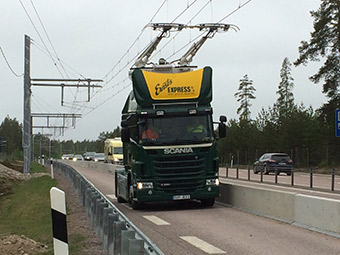The first fossil-free electric road in the world for lorries, route E16 outside the town of Sandviken in North-Central Sweden, was inaugurated in June 2016. Construction of the road attracted considerable interest, both in Sweden and abroad, and the EU-funded subproject ‘Hosting, innovation, regional development and synergies around electric roads for fossil-heavy logistics – VIRUS’ built a visitor centre to host field trips to the site.
VIRUS: Visitor centre for electric lorry route built in Sweden
- 20 November 2019
We have had visitors from Italy, Germany, the Netherlands, Korea, Japan and Norway. Some are mostly interested in the trucks, others in the electricity supply or how we have handled the project itself, for example regarding the laws and procurement regulations.
Most visits to the 2 km section of road begin at the centre. Located in Sandviken’s Sandbacka Science Park, the centre brings researchers and project groups together to work on issues related to security, business models, regulation, operation and maintenance of electric roads, and the creation of ancillary services.
Visitors listen to presentations explaining the background of the road’s development, before visiting the site, watching a demonstration and getting the chance to ride in one of the two specially designed hybrid lorries operating on the route.
Zero-emission transport
Running between the Hillsta junction, near the village of Kungsgården, and Sandviken, the road has electrical contact lines above the right lane, supported by poles placed at 60 m intervals. Lorries connect to the lines via pantographs on their roofs, enabling them to run solely on electricity at speeds of up to 90 km/h while generating no emissions and making little noise. Where the overhead lines end, the lorries switch back to a diesel hybrid system.
Developed in line with all relevant legal requirements following collaboration between industry, academia and public authorities, the system is based on technology similar to that used on tramlines. It is the first of its kind to have been installed on a public road.
Following the inauguration, the route underwent an initial two-year demonstration period. During this time trucks used it for one week each month, to test its effectiveness in different weather and traffic conditions. After the demonstration phase, other customised heavy goods vehicles began using it.
Global contacts for local businesses
Visitors to the centre – who have thus far numbered in excess of 2 200 from 30 countries – help identify opportunities for innovation related to the road and provide new contacts for firms in the region. This means that if a local business has an idea for a potential improvement, it is easy for them to discuss it with other companies elsewhere in the world.
Ideas have emerged for features such as the lighting system and parking spaces with electric charging infrastructure. A spell of cold weather in November 2016 made it necessary to revise the design of the horizontal arms which protrude over the road, to prevent snow from settling on them.
In time, the intention is to electrify the entire section of the E16 between the port of Gävle and the town of Borlänge – a distance of over 100 km. The route could serve as a platform for wider electrification of Sweden’s major roads, which would guarantee clean transport countrywide.
The project has prepared regional SMEs to be part of a new global value chain that will be developed if and when it is time for a full-scale deployment of the overhead electric road system.
Total investment and EU funding
Total investment for the project “VIRUS – hosting, innovation, regional development and synergies around electric roads for fossil-heavy logistics” is EUR 1 200 000, with the EU’s European Regional Development Fund contributing EUR 530 000 through the “North-Central Sweden” Operational Programme for the 2014-2020 programming period. The investment falls under the priority “Decrease CO2 emissions and promote the use of renewable energy in SMEs as well as stimulate research and innovation for low-carbon technologies”.

